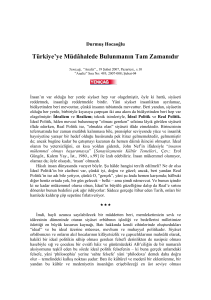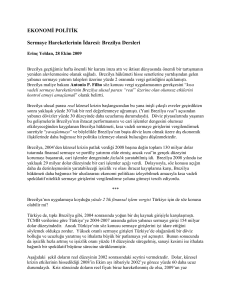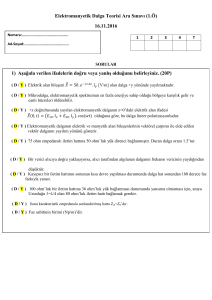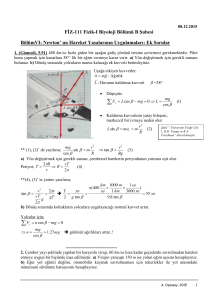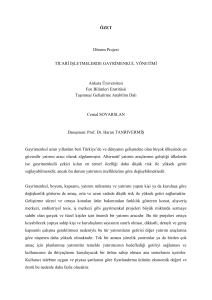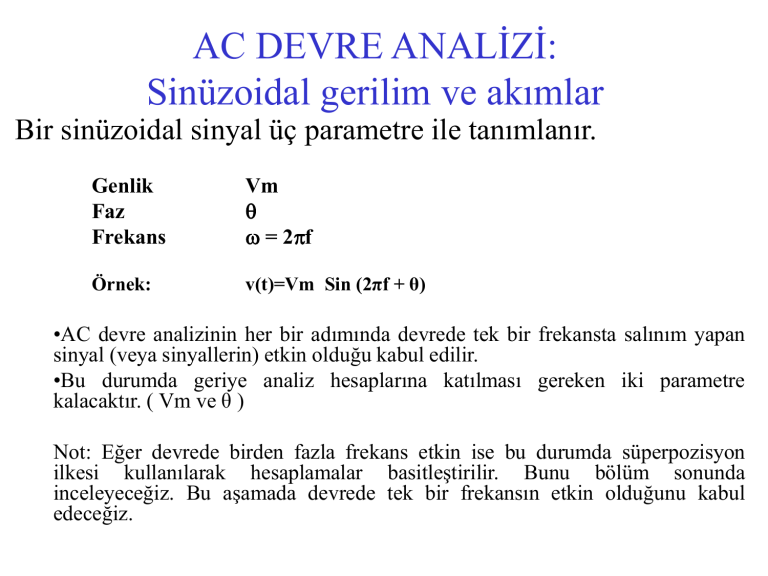
AC DEVRE ANALİZİ:
Sinüzoidal gerilim ve akımlar
Bir sinüzoidal sinyal üç parametre ile tanımlanır.
Genlik
Faz
Frekans
Vm
= 2f
Örnek:
v(t)=Vm Sin (2πf + θ)
•AC devre analizinin her bir adımında devrede tek bir frekansta salınım yapan
sinyal (veya sinyallerin) etkin olduğu kabul edilir.
•Bu durumda geriye analiz hesaplarına katılması gereken iki parametre
kalacaktır. ( Vm ve θ )
Not: Eğer devrede birden fazla frekans etkin ise bu durumda süperpozisyon
ilkesi kullanılarak hesaplamalar basitleştirilir. Bunu bölüm sonunda
inceleyeceğiz. Bu aşamada devrede tek bir frekansın etkin olduğunu kabul
edeceğiz.
NEDEN SİNÜZOİDAL
SİNYALLER KULLANILIRLAR -1
AC SİNYAL ANALİZİNDE
AKIM VEYA GERİLİM KAYNAKLARINI
TANIMLAMAK İÇİN SADECE
GENLİK VE FAZ AÇISI BİLGİLERİNİ
(dikkat sayıca iki adet bilgi söz konusu)
KULLANACAK BİR HESAPLAMA
YÖNTEMİ GEREKLİDİR.
NEDEN SİNÜZOİDAL SİNYALLER
KULLANILIRLAR - 2:
• Doğrusal devrelerde kullanılan pasif elemanlar R, L ve C ’lerden
oluşmuşlardır.
• Bu elemanların akım ve gerilim büyüklüklerini birbirlerine bağlayan
tanım bağıntıları ya ölçekleme yada türev ve integral işlemleri ile
tanımlanmışlardır.
• Sinüzoidal işaretlerinin türev ve integralleri de yine aynı frekansta
salınan fakat genlik ve fazı değişmiş bir sinüzoidal işarete denk gelir:
v( t ) Vm Cos t
Vm
Vm
vt dt Sin t Cos t 90
dv( t )
Vm Sin t Vm Cos t 90
dt
Sinyal v(t), integrali (iv(t) ile gösterilen) ve
türevi (dv(t) ile gösterilen)
0.5 Hz frekansta 10V rms ac sinyal
44.429 60
48
36
dvt n
ivt n
Voltaj [V]
v tn
24
12
0
12
24
36
44.429
48
60
0
0
0.5
1
1.5
2
tn
Zaman [s]
2.5
3
3.5
4
4
NEDEN SİNÜZOİDAL
SİNYALLER KULLANILIRLAR -2
R ELEMANI:
Üzerine sin/cos şeklinde bir AC akım sinyali uygulanması durumunda elemanın
uçları arasında oluşan gerilim sadece genliği R kadar ölçeklenmiş aynı sin/cos
sinyali olacaktır.
C ELEMANI:
Üzerine sin/cos şeklinde bir AC akım sinyali uygulanması durumunda elemanın
uçları arasında oluşan gerilim genliği 1/ωC kadar ölçeklenmiş ve fazı da -900
kadar ötelenmiş aynı sin/cos sinyali olacaktır. (Bakınız C elemanı akım-gerilim
tanım bağıntısı ve sinüzoidal ifade integral işlemi)
L ELEMANI:
Üzerine sin/cos şeklinde bir AC akım sinyali uygulanması durumunda elemanın
uçları arasında oluşan gerilim genliği ωL kadar ölçeklenmiş ve fazı da +900
kadar ötelenmiş aynı sin/cos sinyali olacaktır. (Bakınız L elemanı akım-gerilim
tanım bağıntısı ve sinüzoidal ifade türev işlemi)
NEDEN SİNÜZOİDAL SİNYALLER
KULLANILIRLAR -2
SONUÇ:
AC SİNYAL ANALİZİNDE SADECE
GENLİK VE FAZ AÇISI BİLGİLERİNİ
(dikkat sayıca iki adet bilgi söz konusu)
KULLANACAK BİR HESAPLAMA
YÖNTEMİ GEREKLİ.
NEDEN SİNÜZOİDAL SİNYALLER
KULLANILIRLAR -3:
ACABA BU MAKSATLA KARMAŞIK SAYILAR
(dikkat her karmaşık sayı bünyesinde adları reel ve
imajiner kısım olmak üzere iki adet bilgi ihtiva eder)
KULLANILABİLİRLER Mİ?
SİNÜZOİDAL SİNYALİN KARMAŞIK
DÜZLEMDE GÖSTERİMİ
imajiner
Normalde karmaşıkdüzlemde bir nokta
bir karmaşık sayıyı
ifade eder.
+j
( = 90 veya /2)
orijine olan uzaklık:
Vm
- reel
θ+t
Farklı bir yaklaşım olarak
zamanla konumunu değiştiren bir nokta göz önüne
alalım: bu noktanın θ başlangıç açısı ve ω açısal hızı
ile saatin ters yönünde
döndüğünü kabul edelim.
=0
+ reel
= 180 veya
-j ( = -90 or - /2)
+j ( = 90 veya /2)
v Vm cos2 f t
0.5 Hz frekansta 10V rms ac sinyal
14.142 15
12
Voltaj [V]
9
Vm
+t
= 180 veya
=0
+
reel
- reel
6
v imagt n
3
0
3
6
9
12
14.142
15
-j ( = -90 veya - /2)
5
10
( t)
n
3
4.5
t n
w açısal hızı ile dönen noktanın reel
eksen üzerine iz-düşümü cos(wt) olur
6
7.5
9
10.5
12
13.5
12.566
15
15
12.566
w açısal hızı ile dönen noktanın imajiner
eksen üzerine iz-düşümü sin(wt) olur
0
1.5
açısal frekans [rad/s] . Zaman [s]
0
açısal frekans [rad/s] . Zaman [s]
0.5 Hz frekansta 10V rms ac sinyal
0
0
15
14.142
10
5
0
v real( t) n
Voltaj [V]
5
10
15
14.142
NEDEN SİNÜZOİDAL
SİNYALLER KULLANILIRLAR -3
SONUÇ:
8.4 Relationship between rms and peak
and i and j
• Electrical engineers generally use a slightly different
nomenclature to mathematicians for complex
notation
– Firstly we use j, rather than i, for the square root of –1
(i gets confused with current)
– Secondly, we normally use rms values rather than peak
values to describe the amplitude. For sine waves the peak
is always 1.414 times the rms. (rms values rather than peak
are used to describe voltages and currents)
8.5 Representation of d/dt by j
• We know that a signal represented by the differentiation
of a sinusoidal voltage or current is the equivalent of the
original signal
– Multiplied by
– Advanced in phase by 90 degrees or /2
v(t ) Vm cos(t )
dv(t )
Vm sin( t ) Vm cos(t )
dt
2
• Now multiplying by j gives a phase shift of +90 degrees
• Thus the operation of d/dt on a sinusoidal signal is like
multiplying by j (in the complex plane)
8.6 Impedance of resistors, inductors and capacitors
• Impedance is a term used to describe the
relationship between sinusoidal voltage and
current for
– a single passive component
– a group of passive components
(passive components are R, L and C. They are
passive because they are linear and have no
gain)
• Turev alinca esitlikler ne olur
• Impedance is given the symbol Z
i
v
Z
v=iZ
v=iR
dv
iC
j C v
dt
thus
di
vL
j L i
dt
1
j
v
i
i
j C
C
Note v and i are complex quantities here. (Some books use bold type to
distinguish between complex and absolute values of sinusoidal
voltages and currents or between complex and dc values)
• Thus
ZR R
Z L j L
ZC
j
C
We have two components to the impedance.
One has no j term and is referred to as real
The other is all j terms and is referred to as imaginary
The same is true for voltage and current.
All complex values can be expressed as a magnitude and phase angle
Or as a complex quantity.
Complex voltages and currents are called phasors
8.7 Phasors, Reference Phasor and CIVIL
• A phasor is a term given to a voltage or current which has a real and
complex part. Represented as one of the following forms
v v real j vimag
v vm e
= 90 or /2
j
v v m cos j v m sin
v v m
= 180 or
where
v m v real vimag
2
2
-real
v real
v real
1 v real
arccos
a cos
cos
vm
vm
vm
Note Using the cos function requires the sign
of to be the sign of the imaginary part
In circuits with several voltages and currents
We need to define we need to take
a current or voltage as a reference (i.e. let =0 for that variable)
vm
=0
+
real
- j = -90 or - /2
• Taking the same voltage applied across a parallel combination of a
resistor, a capacitor and an inductor
v
iR
ZR
iL
ZL
iC
ZC
v
i
Z
ZR R
Z L j L
ZC
j
C
• Plotting the voltage and three current phasors on the complex plane
produces a phasor diagram. Voltage is common to all so we take that as
the reference phasor in this case
+ j = 90 or /2
= 180 or
- real
v
=0
+ real
- j = -90 or - /2
• Taking the same voltage applied across a parallel combination of a
resistor, a capacitor and an inductor
v
iR
ZR
iL
ZL
iC
ZC
v
i
Z
ZR R
Z L j L
ZC
j
C
• Plotting the voltage and three current phasors on the complex plane
produces a phasor diagram. Voltage is common to all so we take that as
the reference phasor in this case
+ j = 90 or /2
= 180 or
- real
iR
v
=0
+ real
- j = -90 or - /2
• Taking the same voltage applied across a parallel combination of a
resistor, a capacitor and an inductor
v
iR
ZR
iL
ZL
iC
ZC
v
i
Z
ZR R
Z L j L
ZC
j
C
• Plotting the voltage and three current phasors on the complex plane
produces a phasor diagram. Voltage is common to all so we take that as
the reference phasor in this case
+ j = 90 or /2
iC
= 180 or
- real
iR
v
=0
+ real
- j = -90 or - /2
• Taking the same voltage applied across a parallel combination of a
resistor, a capacitor and an inductor
v
iR
ZR
iL
ZL
iC
ZC
v
i
Z
ZR R
Z L j L
ZC
j
C
• Plotting the voltage and three current phasors on the complex plane
produces a phasor diagram. Voltage is common to all so we take that as
the reference phasor in this case
+ j = 90 or /2
iC
= 180 or
iR
- real
v
=0
+ real
iL
- j = -90 or - /2
• We can see that the phase angle between
current and voltage is
– 0 for the resistor,
– + 90 degrees for the capacitor
– and –90 degrees for the inductor
• A memory aid is the acronym CIVIL
• CIV, for a capacitor (C), current (I) leads
voltage (V)
• VIL, voltage (V) leads current (I) for an
inductor (L)
8.8 Phasor Addition and Complex Arithmetic to Find the
Combined Current for the Previous Circuit
i
v
iR
ZR
iL
ZL
iC
ZC
j
• Find i
i iR iC iL
1
1
1
1
1
1
v
i v
1
Z
Z
Z
R
jL
C
L
R
jC
1
1
i v j C
R
L
By phasor
addition
v
- real
By complex algebra and arithmetic
+ real
iL
-j
8.8 Phasor Addition and Complex Arithmetic to Find the
Combined Current for the Previous Circuit
i
v
iR
ZR
iL
ZL
iC
ZC
j
• Find i
i iR iC iL
1
1
1
1
1
1
v
i v
1
Z
Z
Z
R
jL
C
L
R
jC
1
1
i v j C
R
L
By phasor
addition
v
- real
By complex algebra and arithmetic
+ real
iL iR
-j
8.8 Phasor Addition and Complex Arithmetic to Find the
Combined Current for the Previous Circuit
i
v
iR
ZR
iL
ZL
iC
ZC
j
• Find i
i iR iC iL
1
1
1
1
1
1
v
i v
1
Z
Z
Z
R
jL
C
L
R
jC
1
1
i v j C
R
L
By phasor
addition
v
- real
By complex algebra and arithmetic
iC + real
iL iR
-j
8.8 Phasor Addition and Complex Arithmetic to Find the
Combined Current for the Previous Circuit
i
v
iR
ZR
iL
ZL
iC
ZC
j
• Find i
By phasor
addition
i iR iC iL
1
1
1
1
1
1
v
i v
1
Z
Z
Z
R
jL
C
L
R
jC
1
1
i v j C
R
L
- real
By complex algebra and arithmetic
i
i
iL iR
-j
v
iC + real
8.9 General Circuit Solution
• We can solve ac networks with the same
tools and methods used for dc networks
– Must use complex representation of voltages,
currents and impedances
– Must choose one current or voltage as reference
phasor and relate all others to it in terms of the
phase angle
• Evaluation of power needs care (rms values help)
• Evaluation of stored energy needs care
8.10 Instantaneous power, real power and reactive power
Instantaneous power waveforms for a voltage of 2V peak and a current of 1.5A peak
Flowing separately in a resistor, a capacitor and an inductor
3
v t n
2
4
v t n
2
i t n
i t n
P t n
2
2
1
0
P t n
0
1
2
2
0
0
1
2
3
tn
2
4
2
2
0
1
0
tn
4
Resistor case
3
4
4
Inductor case
v t n
Average power
Pav=0.5Vm*Im
Pav=vrms*irms
2
i t n
1
Pav = 0
0
P t n
1
2
2
0
0
1
2
tn
3
4
4
Capacitor case Pav = 0
EMPEDANS
Sinüzoidal (sin veya cos tipi) alternatif akıma
gösterilen karşı koymanın (direnimin) ölçüsüdür.
Biri reel diğeri sanal olmak üzere iki bileşeni vardır:
– Reel bileşeni klasik direnç gibi davranmanın ölçüsünü
tanımlayan REZİZTANS olarak adlandırılır.
– Sanal bileşen ise bobin veya kapasite gibi davranmanın
ölçüsünü tanımlayan REAKTANS olarak adlandırılır.
Empedans = Rezistans + j.Reaktans
şeklinde tanımlı olup, genellikle EE uygulamalarında
Z=R+jX
ile sembolize edilirler.
EMPEDANS
• DİRENÇ: değeri R0 olan elemanın
Rdirenç= R0 ve Xdirenç=0 ise
ZR=R
• BOBİN: değeri L olan elemanın
Rbobin= 0 ve Xbobin=ωL ise
Zbobin=jωL
• KAPASİTE: değeri C olan elemanın
Rkapasite= 0 ve Xkapasite=-1/ωC iseZkapasite=1/jωC
ADMİTANS
Elektrik devrelerinde Sinüzoidal (sin veya cos tipi)
alternatif akıma
gösterilen karşı koymanın (direnimin) ölçüsüdür.
Biri reel diğeri sanal olmak üzere iki bileşeni vardır:
– Reel bileşeni klasik direnç gibi davranmanın ölçüsünü
tanımlayan REZİZTANS olarak adlandırılır.
– Sanal bileşen ise bobin veya kapasite gibi davranmanın
ölçüsünü tanımlayan REAKTANS olarak adlandırılır.
Empedans = Rezistans + j.Reaktans
şeklinde tanımlı olup, genellikle EE uygulamalarında
Z=R+jX
ile sembolize edilirler.


